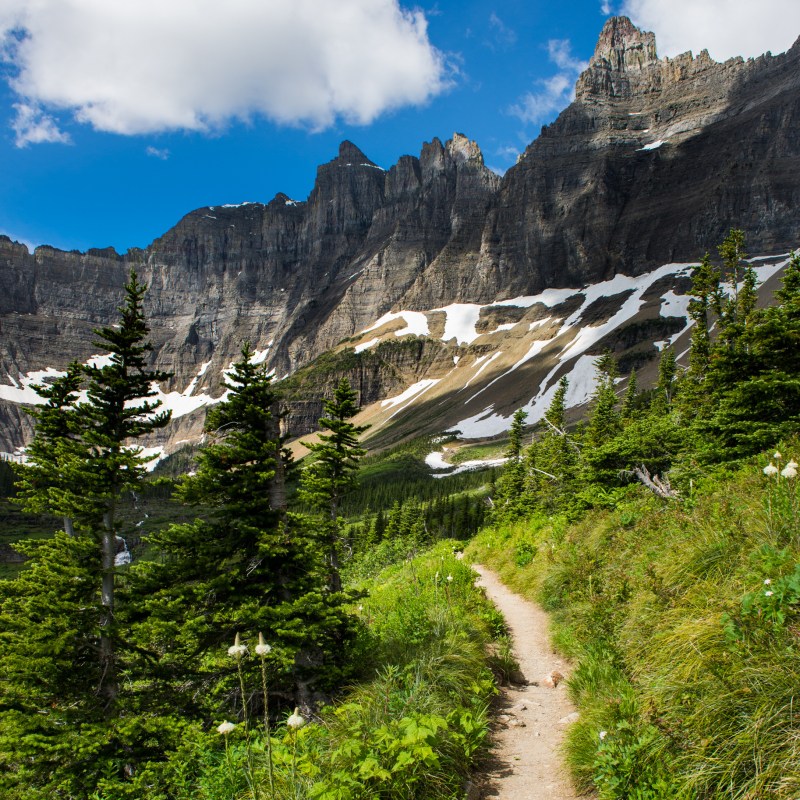
What’s not to like about spending time in a beautiful national park, enjoying nature and family?
Videos by TravelAwaits
Glacier National Park has become a destination for about 3 million visitors a year who come to explore the million acres of parkland, crisscrossed by 750 miles of hiking trails.
Glacier is the last place in the Lower 48 states to see grizzly bears, and there are still more than 20 glaciers sitting on top of the mountains. Glacier may well be the last wild place in the Lower 48, what with wolves and bears and elk and mountain goats.
The hiking trails range from gentle strolls along creeks and lakes that are very flat and easy to much more aggressive hikes that take you up thousands of feet and across many miles of parkland. Like any foray into the wild, be aware of your surroundings, pack plenty of water, and remember: This isn’t a theme park. There are few guardrails to protect hikers, and, mostly, you are in charge of your own safety.
Be sure to pick up a park guide and map from the rangers at any entry station. The guide has tips on what to do in the park, including how to be aware of bears and how to deal with a bear encounter. The guide includes shuttle bus times as well as times for special ranger-led hikes and evening presentations.
I’ve selected a number of hikes, from the one that gets you acclimated to the forest and the elevation to a few that are strenuous but worth the effort.
Let’s get walking.

Mike Owens
1. The McDonald Creek Trail
The McDonald Creek trailhead is just about a half mile from the Going to the Sun Road and just about a mile east of Lake McDonald Lodge. The hike is almost seven miles round trip, but since the trail follows the creek, it’s essentially flat. That means it’s a great tune up hike for longer and steeper hikes. The path itself is easy to follow. It winds along the creek but veers away at times into the nearby forests. The trail offers great streamside views and, about halfway along, a huge flat rock that is a perfect spot for a break.
While the views aren’t from high above a mountaintop, there is a possibility of a moose sighting. Beavers have dammed up part of the creek in a cedar forest and moose have been known to frequent the area. The best time to do this hike is early or late in the day when you have a greater chance of seeing wildlife. Be prepared and pack
2. Avalanche Lake Trail
The trailhead is further east of Lake McDonald, across from the Avalanche Creek Campground. It’s a total of about six miles, but it has a 500-foot elevation gain, so it’s much steeper than the McDonald Creek trail. It’s a clearly marked trail and my advice is go early or late since this is one of the most heavily traveled hiking trails in the park. Avoiding crowds also means you’ll have a better chance at the limited parking. Or, you can avail yourself of the free park shuttle bus system. It will take you from the Apgar Visitor Center right to the trailhead. The shuttles run frequently and make stops all throughout the park.

Mike Owens
3. The Highline
This is a long hike, so be prepared with extra water, lunch, and strong legs. The trail is almost 12 miles and involves taking a shuttle either to or from your car. The Highline follows the Garden Wall, a mountain structure created by glaciers that divides the east and west sides of the park. You can start the hike at Logan Pass, and the beauty of starting at the pass and walking to your car is that it is mostly downhill.
To do this, you’ll want to park your car at the parking area at the Loop, which is clearly marked. Then, take the shuttle to Logan Pass. The trail is well marked and heavily traveled. It is sometimes closed due to bear activity or fog or ice, so have a backup hike prepared.
The start of the Highline, which is along a rock wall, is so narrow that the National Park Service has provided a steel cable handrail to hang on to. The views from the trail include the Logan Creek Valley and the McDonald Valley. There is a spur trail that’s about a mile and a half round trip that takes you to an overlook of the Grinnell Glacier. Great view, steep walk.
For lunch, you’ll end up at the Granite Park Chalet. It’s a lodging chalet, but for day hikers it’s a great spot for lunch and a toilet break. You can buy some food and water there, but the prices are as steep as the coming trail. After the chalet, you’ve got four miles to walk downhill to the Loop parking lot. It’s a steep trail through the remains of the 2003 Trapper Creek forest fire. You’ll have great views of Heaven’s Peak, and before you get to the Loop, the trail crosses a creek. It’s a great spot to rip off your boots and cool your toes.

Mike Owens
4. Hidden Lake
Hidden Lake is accessed from Logan Pass and is one of the most popular, and crowded, hikes in the park. If the Highline isn’t doable, Hidden Lake is next best. Round trip to the lake, it’s six miles. Or it’s just three miles to the overlook. To the lake makes for a strenuous walk. To the overlook, it’s less so. The walk begins right outside the Logan Pass visitor center and begins on a boardwalk that was built to protect the tundra environment.
You’ll be walking through wildflowers, no matter what time of summer you visit. The boardwalk ends when you reach a plateau, and this is where Hidden Lake really shines. Look around for the wild animals. To your right, on cliff faces, there may be bighorn sheep. Look carefully; their coat is the same color as the surrounding rock. Amid the brown rock, you may also see white mountain goats. The goats also spend time in some trees alongside the trail. Don’t bother them. They have very sharp horns.
The payoff: a mountain lake after another one and a half miles. And you’ll be pretty much alone since most hikers go to the overlook and turn around. A word of caution: The Logan Pass parking lot is usually full up by 8 a.m.
5. Siyeh Bend To Sunrift Gorge
This is another shuttle bus walk, and it’s got it all. It’s moderately strenuous, takes you through a low forest then to a rocky park, up a steep scree slope, to a mountain pass, and then back down the other side of the pass through the Baring Creek Valley.
Park your car at the Siyeh Bend bus stop and look for the trailhead by following Siyeh Creek. At the beginning of the trail, look for elk. In the higher areas, look for the elusive pika. It hides under rock and makes bird-like chirps. Also among rocks at lower elevations are larger rodents called marmots.
Have your lunch at the pass. There’s some exploring to do there, and then it’s all downhill to the gorge. If you are feeling extra energetic, there’s a spur trail that will take you to the Sexton Glacier. It looks like a short walk, but it isn’t. Continue down the valley to the gorge, following Baring Creek. There are some great spots to stop near the water and cool your feet. When you get to the road, make a hard right, and there’s the bus stop that will take you to your car parked at Siyeh Bend.

Mike Owens
6. Iceberg Lake
This mountain lake is a brilliant aquamarine and is a nine mile round trip from the trailhead, which is located behind cabins at the Swiftcurrent Motor Inn complex in the Many Glacier Valley. It’s a relatively easy walk. The trail offers views of Mount Wilbur on the south and Altyn Peak. The trail winds through forests leading to the Ptarmigan Falls, a great spot to catch your breath.
The trail rises and loops around to the south. The lake is surrounded by 3,000-foot cliffs, and you can look out for goats on the rocky slopes. The ice never fully leaves the lake, and the unwritten rule is that first time visitors must swim in the icy water and attempt to climb up on an iceberg. That effort is usually left to 20-somethings.
7. Scalplock Mountain
Getting to this trailhead takes you outside the park proper, but the hike itself is in the park. Drive U.S. Highway 2 to near Essex and then look for the Walton Ranger Station sign. That’s where you turn and will find plenty of parking.
The trail is steep in spots, but the walk is well worth it. The payoff: an old-fashioned fire lookout. With luck, there will be a human manning the fire tower and they usually want to show off their office/home. The fire spotters get fresh food every two weeks, and it’s polite to offer the spotter a fresh apple or banana if you have one in your pack. There are incredible views of glaciers from the lookout and, to the south, you can look into the vastness of the Bob Marshall Wilderness.

Mike Owens
8. Scenic Point
This is a tough little hike. It’s not quite eight miles round trip, but it’s pretty steep in spots. This hike takes you to 7,500 feet, with an elevation gain of about 2,200 feet over about four miles.
Scenic Point is in the Two Medicine Valley; locals call it Two Med. The valley is dominated by three mountains that are named for a famous family of Blackfeet Indians. You’ll want to take your lunch break at the top of the mountain, and if you’ve been jonesing to use your cell phone, here’s your chance. Most of the park is without cell phone reception. There are strong cell signals from this spot. The view is 100 miles, all the way out to the Sweet Grass Hills. Much of the view is of the Blackfeet Reservation, a million acres set aside for the tribe that once roamed all of Glacier National Park.
This list of hikes is a tiny fraction of the walks in Glacier. I’ve walked each of these hikes in my years at Glacier, where I work in the summer months as a Red Bus tour driver. A Red Bus tour is a great way to learn about the park and leave the driving on the Going to the Sun Road, the challenging drive that bisects the park east to west, to someone else.
A final word: You don’t have to hike miles into backcountry to enjoy the park. Two hundred feet off any road can put you into deep forest next to a creek or a valley. A hike is what you make it. Enjoy.
Most of the east side of the park — including eastern entrances — will likely remain closed for the 2020 season. For the latest updates, check out our full list of national parks requiring changes for visitors.
